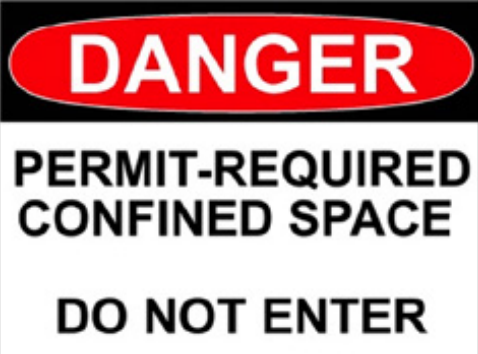
Minimal Requirements of OSHA’s Permit Required Confined Space Standard for All Employers
The Occupational Safety and Health Administration’s Standard on Permit Required Confined Spaces is as vast as outer space itself. Despite its significant size, each of the regulations included within it are critical towards saving lives. This article focuses on the beginning steps that all employers must take in order to assess compliance with the standard and determine whether additional steps may need to be taken in order to protect employee safety and health.
The first step in understanding OSHA’s PRCS Standard, is knowing what a confined space, as well as what a permit required confined space is. Per 29 CFR §1910.146(b), a confined space is “any space that:
- Is large enough and so configured that an employee can bodily enter and perform assigned work; and
- Has limited or restricted means for entry or exit (for example, tanks, vessels, silos, storage bins, hoppers, vaults, and pits are spaces that may have limited means of entry); and
- Is not designed for continuous employee occupancy."
Examples of what a confined space could be include but are not limited to: silos, vats, hoppers, utility vaults, tanks, water supply towers, sewers, pipes, access shafts, truck or rail tank cars, aircraft wings, boilers, manholes, pump stations, digesters, manure pits and storage bins. Once it is understood what confined spaces are, it is necessary to know what the difference is between a confined space, and a permit required confined space (or PRCS, for short).
To summarize the difference between these two spaces; a PRCS is simply a confined space, that has one or more serious safety hazards associated with it; where if an employee must enter the confined space to perform work, he or she will become exposed to those hazards. Generally, safety hazards associated with confined spaces are considered to be “serious” safety hazards, meaning that if an employee is exposed to the hazard, there is a high likelihood that serious injury or death will occur.
The definition of a permit required confined space is also found at 29 CFR §1910.146(b), and provides insight to the specific kinds of serious safety hazards that OSHA wants employers to consider when evaluating whether a confined space may be a PRCS. The definition states that “a permit required confined space is a confined space that has one or more of the following characteristics:
- Contains or has a potential to contain a hazardous atmosphere;
- Contains a material that has the potential for engulfing an entrant;
- Has an internal configuration such that an entrant could be trapped or asphyxiated by inwardly converging walls or by a floor which slopes downward and tapers to a smaller cross-section; or
- Contains any other recognized serious safety or health hazard.”
Part of the reason these spaces have their own safety standard specifically developed for protecting employee safety and health, is that the abnormal configuration or functionality of these spaces are hazards themselves or tend to complicate the means in which other hazards associated with the spaces may be controlled.
For example, if an employee was to become seriously injured while working in a PRCS, rescuing or responding to that employee will frequently be a complicated and hazardous endeavor. One of the most common fatalities associated with PRCS, occurs when an employee becomes injured or loses consciousness while working inside a PRCS, and another employee attempts to rescue the employee without having an adequate plan in place or without having enough knowledge about the hazards that injured the employee he or she is attempting to rescue, frequently resulting in the second employee also being seriously injured after being exposed to the same hazard.
Another reason the standard was promulgated includes that sometimes the work that must occur inside the space creates a hazard that may not otherwise exist when not in a “confined space.” For example, depending on the circumstances, an employee painting the side of a house with paint containing volatile organic compounds (VOCs) may not be exposed to any atmospheric hazards associated with VOCs; but when that same employee paints the inside of a grain bin, the VOCs in the paint are not able to disseminate to the outside air, potentially exposing the employee to excess vapors in the air.
Permit Required Confined Spaces – Employer Requirements
Technically, OSHA’s PRCS Standard is a standard that all employers must comply with, at least as it relates to one specific regulation contained within the standard; 29 CFR §1910.146(c)(1) which states, “The employer shall evaluate the workplace to determine if any spaces are permit-required confined spaces.” The requirement speaks for itself. Each employer must ensure that their workspace has been evaluated for PRCS; once this evaluation has been made, additional requirements will apply depending on whether or not PRCS do exist in the workplace, and whether or not employees at any time must perform work inside any of these spaces.
Take for example, a mixing tank used at a facility that manufactures chemicals or food products. Would such a tank be considered a confined space?
Let’s look at the definition of a confined space again: the tank is large enough for a person to enter with their body, if the person were to enter the tank it would not be through a standard entry or exit point (they would have to climb in and out of the tank, as opposed to walking right in or out of it), and the tank is clearly not designed for normal occupancy.
These elements make the tank a confined space; but what makes this tank a PRCS? The answer is the auger / mixing arm that is associated with the tank. This satisfies the 4th element of the PRCS definition - that a “serious” safety hazard is associated with the space which is not a hazardous atmosphere, engulfment, or internal configuration hazard. If a person were required to enter the mixing tank to perform work without locking out and tagging out the mixing arm, then that person could be seriously injured if the mixing arm were mistakenly or inadvertently activated while the person is performing work
inside the tank.
This also sheds light on why permit required confined spaces are actually called “permit required” confined spaces. OSHA has determined that a critical element for controlling the hazards associated with these spaces is to require the employer to address the means in which the hazards must be controlled by requiring that entry teams use a written permit which ensures that the appropriate steps are taken in order to control the hazards. In the instance of the mixing tank above, an entry permit for this space would need to include instruction to de-energize and lock-out the mixing arm associated with the tank.
Once the employer has conducted the PRCS evaluation; the standard minimally requires a few additional steps be taken where PRCS are known to exist. The first being that the employer must provide appropriate signage at or on the space to remind employees that the space poses a hazard1.
The next requirement the employer must abide by is to determine whether employees will actually need to enter these spaces in order to perform any work. For the purposes of enforcement, OSHA defines “entry” as, “the action by which a person passes through an opening into a permit-required confined space. Entry includes ensuing work activities in that space and is considered to have occurred as soon as any part of the entrant's body breaks the plane of an opening into the space.” Employers must exercise sound discretion when determining whether or not entry is occurring, relative to the hazards that are present, as careful and proper application, implementation, and utilization of the program is critical towards saving lives.
If it is determined that employees are being required to enter PRCS, then full and complete implementation of the PRCS program is necessary. This includes the incorporation of all the applicable elements of the standard minimally including:
- Having a written PRCS Program,
- Training on the program,
- Issuance and retention of written entry permits, and
- Ensuring considerations are made for safe use of equipment within the space.
Where employers know that these spaces exist and employees must enter them to perform work, it is imperative that a robust understanding of the standards requirement exists among all employees associated with PRCS operations.
“We are not here to curse the darkness, but to light the candle that will carry us through that darkness to a safe and sane future.” John F. Kennedy
1Signage - 29 CFR §1910.146(c)(2) states, “If the workplace contains permit spaces, the employer shall inform exposed employees, by posting danger signs or by any other equally effective means, of the existence and location of and the danger posed by the permit spaces. NOTE: A sign reading DANGER -- PERMIT-REQUIRED CONFINED SPACE, DO NOT ENTER or using other similar language would satisfy the requirement for a sign.”

03052020
Related Topics: The Consultant's Corner